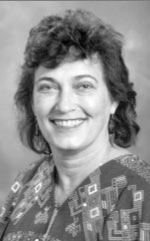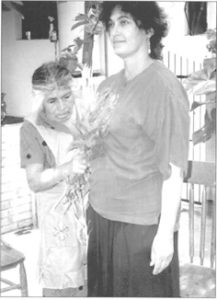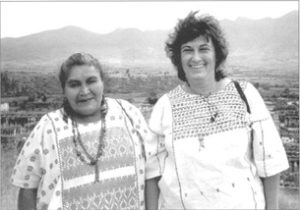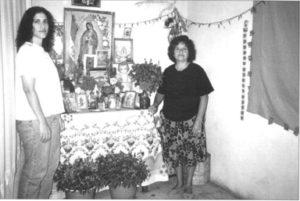|
“Te n n
Curandera Dona Berta from Oaxaca performs an energy cleansing on Sandra Hurlong (right).
Indians approached us wearing long white cotton robes which reached to their feet. They had long hair so matted with blood that it would be impossible to part or even comb unless it were cut. These Indians were priests…and they brought before us large containers of incense full of a resin which they called copal. With clay braziers full of burning embers they began to smudge us thoroughly with incense.”
March 7, 2011
I often recall Diaz’s words when I visit a contemporary curandero in Oaxaca, as many of the healing rituals are
ancient. Curanderismo is a traditional healing system in Oaxaca, practiced by curanderos, or healers. During a visit to Oaxaca in November 2000 I decided to visit a curandero to help my recovery from pneumonia and a knee injury. I thought a healing session with a curandera to balance and cleanse my body’s energy would be beneficial. I first went to the herb stand in the Juarez market to buy the cleansing bouquet I knew the curandera would need and carried it with me to her house. Upon my arrival, the curandera lit a brazier full of copal incense and began to move the incense all around my body. She then moved out to the rest of the room until the clouds of incense were so dense that it was difficult to see. Eventually, she rested the incense brazier in front of her altar. As the smoke settled, she spread a circle of alcohol around me and set it alight so that I was encircled by fire. Then she asked me to sit in front of the altar, and she began a cleansing ritual, or limpia. Using the herbal bouquet of basil, rosemary, piru leaves, and red flowers that I had brought with me, the curandera rubbed my entire body while praying for my health. She prayed in the name of the Virgin Mary, Christ, and La Virgen de la Soledad, the patron saint of Oaxaca. Once she had rubbed my entire body, she drank small mouthfuls of mezcal, a strong local alcoholic drink, and began spraying my body from head to foot. She burped loudly and frequently during the entire time of my limpia. Finally, she stood before me and told me that I was suffering from problems with my lungs and inflammation in my knee, and that I also suffered from envidia, envy. She prescribed herbal teas to reduce inflammation and asked me who could be so envious of me that they were damaging my health. (I hadn’t told her of either of my ailments). Finally, she instructed me to buy an image of San Alejo (St. Alexis), put it on my altar, and pray to him, since he represented qualities I needed to heal.When I left my healing session with the curandera, I felt relaxed and mentally calm. Since I did not know who St. Alexis was, I stopped at a well-known store for religious images and asked for St. Alexis and for literature about him. I learned that St. Alexis is known as an intermediary with God and intervenes for the qualities of patience and tranquility.
This brief description gives some sense of a healing session with a curandera. Healing normally begins with a limpia, or energy cleansing, which serves as a spiritual and physical diagnostic tool for the curandera. Sometimes curanderos use an egg rather than a bouquet to perform the cleansing. At the end of the cleansing, the curandera may break the egg into water to diagnose the illness or, as in my case, may make the diagnosis while cleansing with the herbal bouquet.
In contemporary Oaxaca, curanderos are one of the various categories of traditional healers including: herbalistas, herbalists; hueseros, bone setters; parteras, midwives; hechiceros, spell casters; and brujos, witches. While curanderos may overlap with any of the other forms of traditional healing, curanderos are the healers who specifically address the spiritual component of illness. Therefore diagnoses have two aspects, one physical and one spiritual. Curanderos seek to identify the specific physical illness and simultaneously diagnose the spiritual cause of the illness. Common diagnoses for illness are susto or espanto, soul loss or fright; mal de ojo, evil eye (more often a diagnosis for children); tristeza, sadness or depression; and envidia, envy.
Remedies for illnesses are specific herbs to treat the physical symptoms and advice to treat the spiritual component of the illness. Curanderos also frequently work with those patients diagnosed with soul loss to call their souls back into their bodies using candles, circles of fire, incense, and chants. Sometimes curanderos go with a patient back to the place in which the fright or soul loss occurred, believing that this will facilitate the return of the wayward soul and restore the patient ‘s health.While curanderas often travel long distances to see the ill, they generally prefer to heal in front of their own altars that are adorned with incense, flowers, basil, candles, images of patron saints, virgins, crucifixes, and a container of water to absorb negative energy. The altars represent a sacred space for healing and are a safe and familiar environment for the curandera or curandero.
The healing rituals of the curanderos illustrate close linkages between the knowledge of herbs and the Catholic belief system. Mexican scholar Gonzalo Aguirre Beltran (1992, p.257) points out that curanderismo developed from the process of native healers choosing the operative elements from popular Spanish medicine in the 16th century and combining them with elements of indigenous healing.
Historical accounts relate the differing perspectives on illness and healing among the Spaniards and indigenous populations of the 16th century. Dominican priests from Spain, largely from Andalucia, were among the first to have contact with the indigenous peoples of Oaxaca. The priests traveled throughout the area building churches and converting as many of the local population as possible. In 1579, less than 40 years after Cortez laid claim to large tracts of land in what is now Oaxaca city, the church requested a report from each of its dioceses in the area of Oaxaca. This report, “Papeles de Nueva Espa” or “Papers of New Spain,” meticulously chronicles life in Oaxaca between 1579 and 1581. The priests reports comment on everything from the kinds of crops grown in Oaxaca to healing practices.
The comments about healing included in these reports have important implications for practices of contemporary curanderismo. It is fascinating to see from the priests perspectives what they considered healing and to hear in the Spanish priests accounts what the indigenous peoples considered healing and illness. For example, in an account from Ixtepec diocese, the priest’s comments show that he defines medicine only in terms of the herbs that he knows from Spain. He writes, They have neither experience of herbs, nor roots, nor stones for healing? nor do they use any medicines. If they should wound themselves on some part of their body, they cure it with the pit of an avocado, which they grate into a powder, mix with salt and put into the wound and in this way the wound is healed. (1982, p.19, Hurlong translation) Another account from Tlalistac, in which the priest quotes the indigenous elders, reveals that the elders define illness as something brought by the Spanish.
In earlier times, they did not know any illnesses other than colds and fevers, but after the arrival of the Spaniards came illnesses that caused death and they did not understand what the cause of this was. (1982, p. 49, Hurlong translation) In a further account from Chinantla, the priest’s comments reflect again an ethnocentric view of medicine, including the abhorrence of bathing. He writes, They have no medicines and are only cured by the passage of time. They bathe in the river for any illness, but by means of legislation we have stopped them from bathing… They have one remedy in which they use a hollow cane, such as we have in Castilla, which they fill with Pigietl (diquidunbar), light up and they take the smoke for a cough and for a cold and it is very effective. For pain, they bleed themselves and bathe in hot water. (1982, p.63, Hurlong translation).

Curandera Dona Berta from Oaxaca performs an energy cleansing on Sandra Hurlong (right).
A final example from Cuicatlan in northern Oaxaca acknowledges that there are many Herb specialists among the Indian population. He writes, There are many male and female Indians who are called in the Mexican language, ticitl, who cure with herbs. Those who cure with herbs and roots come from all nations. One of the herbs they use is olotl, which is the name given to the heart of the ear of corn. This herb is useful for molar pain, as a purge, to regulate the menses, and against all serpent bites. (1982, p. 36, Hurlong translation)
From these brief accounts written in the late 1500s, the different concepts of medicine, illness, and healing between the Spaniards and the indigenous population in Oaxaca are evident. The Spanish define medicine in terms of the herbs and roots with which they are familiar and the indigenous populations define illness in terms of the pestilence brought by the Spanish. This is the context from which curanderismo emerged in Oaxaca.
Many of the most common herbs used by present-day curanderos in Oaxaca were brought by the Spanish clergy. For example, chamomile, rue, rosemary, mint, thyme, oregano, mallow, violet, anise, and fennel are among the most frequently prescribed remedies. From the earliest colonial times, European herbs appear in the descriptions of products in the boticas, or apothecaries of the late 1500s in Oaxaca. Friar Francisco de Burgoa mentions the many aromatic herbs, fruits, and flowers such as roses from Alexandria, carnations, and lilies, which were brought to the apothecaries for making unguents and drinks and were also brought to the convents in Oaxaca to adorn the churches. (Burgoa 1997, p. 212)
 Curandera Enriqueta Contreras with Sandra Hurlong (right) Curandera Enriqueta Contreras with Sandra Hurlong (right)
at the sacred site of Yagul, Oaxaca.
The prevalence of old-world herbs is one of the elements of curanderismo that made me want to explore curanderismo in contemporary Andalucia in order to place the Oaxaca practices in a broader context. In an effort to understand the Spanish roots of curanderismo, I traveled to Granada, Spain. My rationale for selecting Granada was that the Dominican order that colonized the region of Oaxaca in Mexico and the first archbishop of New Spain was a Dominican from an area just outside Granada. Since I was already familiar with the Barrio Realejo, where my sister lives, and since this is the barrio that contains a principal Dominican church from the 16th century, I decided to start my inquiry there.
I arranged to talk to Padre Urbano, a noted scholar and Dominican priest from Barrio Realejo. I asked Padre Urbano to speculate as a Spaniard and as a Dominican about what might be the origins of several cultural traits in Oaxaca that are associated with curanderismo and religious festivals. In the course of our discussions I mentioned my research on curanderismo. To my surprise, Padre Urbano was familiar with numerous curanderos in Granada. He said many of his parishioners consulted curanderos, one of whom, La Purisima, was very famous. He offered to put me in contact with the parishioner who could connect me with the curandera.
As a result of my conversation with Padre Urbano, I began to visit and interview Spanish curanderos and herbalists. I was surprised to find that the altars of the Spanish curanderos could be interchanged with those in Oaxaca. They too displayed a variety of saints, virgins, crucifixes, candles, flowers, and herbs. The old-world herbal remedies were used for the same ailments as in Oaxaca; for example, the use of pennyroyal for a hangover.
My conversation with Padre Urbano also helped me to see a different aspect of the relationship between priests and curanderos and to imagine what might have happened with the convergence of 16th century Spanish culture and indigenous culture. The priests who arrived to colonize Oaxaca often had a thorough knowledge of the healing herbs of Spain and surely used that knowledge as disease ravaged their dioceses. They would also have known, just as Padre Urbano did in contemporary times, who were the healers in the community. From the historical and contemporary accounts of curanderos we know the priests sometimes called upon them to exercise their healing knowledge in their communities. The priests encouraged healing in the name of Christianity. Indeed, one well-known Oaxaca curandera became an active healer at the request of the village priest who recognized her healing talent and was concerned for the health of his parishioners since no medical doctor was available.
In contemporary accounts of healing among curanderos, it is a frequently overlooked fact that an important part of the cosmology of curanderismo comes from Catholicism.
Curanderismo is a unique example of cultural continuity from the 16th century and as a healing form it provides an insight into 16th century thought and cosmology. Given the popularity and persistence of the tradition, curanderismo and its cosmology of healing continue to be relevant in contemporary society.
 Curandera Leonor Ramirez in front of her altar with a client in Ocotl¡n, Oaxaca. Curandera Leonor Ramirez in front of her altar with a client in Ocotl¡n, Oaxaca.
BIBLIOGRAPHYAguirre Beltran, Gonzalo (1992) Medicina y Magia: El proceso de Aculturación en la Estructura Colonial, reprint of 1963 edition, Fonda de Cultura Económica, Mexico, D.F.Burgoa, Francisco de (1997) Geográfica Descripción de la parte septentrional, de Polo Artico de la America, 1674 Tomos I-II Edicion facsimilar, Gobierno del Estado de OaxacaDiaz del Castillo, Bernal (1950) Historia Verdadera dela conquista de La Nueva España, Espasa-Calpe, Mexico, D.F.Papeles de Nueva España,(1982) Segunda Serie Geographica y Estadistica, Tomo IV: Relaciones Geographicas de la Diocesis de Oaxaca, años1579-1581, manuscritas de la Real Academia de Historia de Madrid y del Archivo de Indias en Sevilla. Edicion Facimilar de 1905Suggestions for Further Reading:Sesia, Paola, Ed., Medicinia Tradicional, Herbolaria y Salud Comunitaria en Oaxaca, Oax,Oax, CIESAS 1992Trotter, Robert T., and Chavira, Juan Antonio, Cuanderismo: Mexica American Folk Healing, Athens, GA., Univ. of Georgia Press, 1997Mehl-Madrona, Lewis, Coyote Medicine, N.Y., N.Y., Scribner 1997
|

 n
n

 Curandera Leonor Ramirez in front of her altar with a client in Ocotl¡n, Oaxaca.
Curandera Leonor Ramirez in front of her altar with a client in Ocotl¡n, Oaxaca.